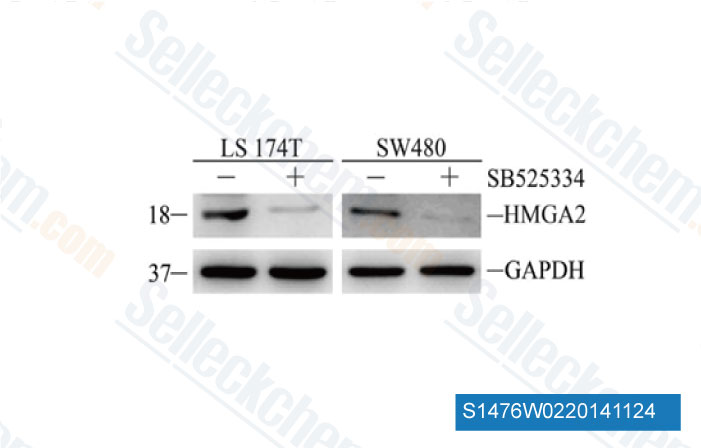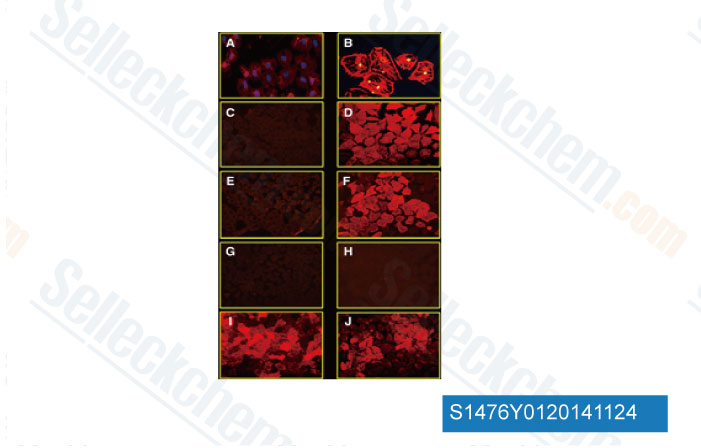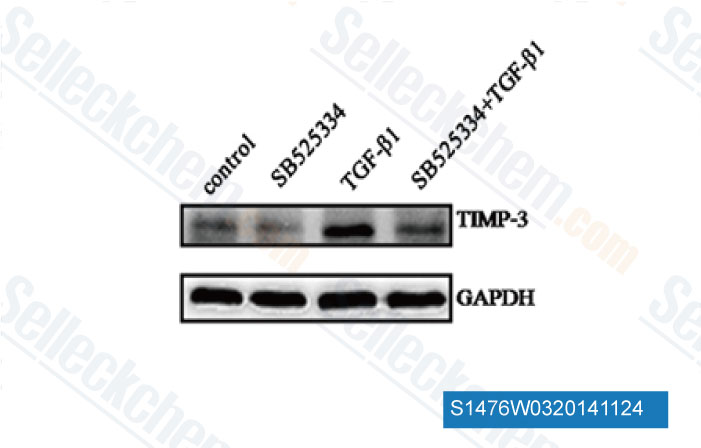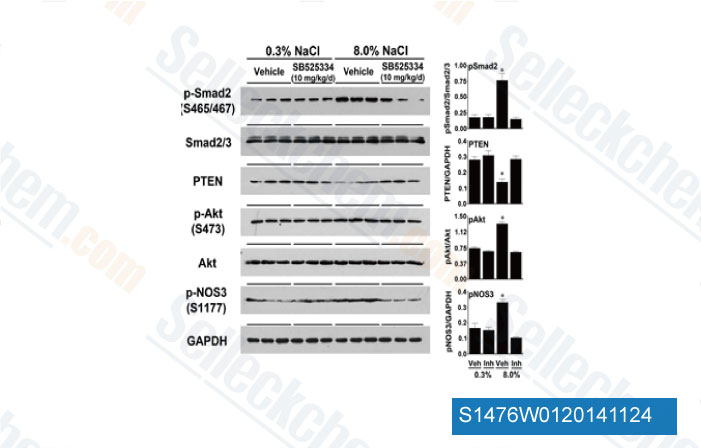|
Toll Free: (877) 796-6397 -- USA and Canada only -- |
Fax: +1-832-582-8590 Orders: +1-832-582-8158 |
Tech Support: +1-832-582-8158 Ext:3 Please provide your Order Number in the email. |
Technical Data
| Formula | C21H21N5 |
|||
| Molecular Weight | 343.42 | CAS No. | 356559-20-1 | |
| Solubility (25°C)* | In vitro | DMSO | 68 mg/mL (198.0 mM) | |
| Ethanol | 68 mg/mL (198.0 mM) | |||
| Water | Insoluble | |||
|
* <1 mg/ml means slightly soluble or insoluble. * Please note that Selleck tests the solubility of all compounds in-house, and the actual solubility may differ slightly from published values. This is normal and is due to slight batch-to-batch variations. * Room temperature shipping (Stability testing shows this product can be shipped without any cooling measures.) |
||||
Preparing Stock Solutions
Biological Activity
| Description | SB525334 is a potent and selective inhibitor of TGFβ receptor I (ALK5) with IC50 of 14.3 nM in a cell-free assay, 4-fold less potent to ALK4 than ALK5 and inactive to ALK2, 3, and 6. | ||
|---|---|---|---|
| Targets |
|
||
| In vitro | SB 525334 shows no inhibition in the enzymes ALK2, 3, and 6, with IC50 values > 10 μM. SB 525334 blocks phosphorylation induced by TGF-β1 and nuclear translocation of Smad2/3 in renal proximal tubule cells. SB 525334 also inhibits the increased mRNA expression levels of plasminogen activator inhibitor-1 (PAI-1) and procollagen α1(I) induced by TGF-β1 in A498 renal epithelial carcinoma cells at 1 μM). [1] SB 525334 (1 μM) attenuates the heightened sensitivity to TGF-β1 exhibited by pulmonary artery smooth muscle cells (PASMCs) from patients with familial forms of idiopathic pulmonary arterial hypertension (PAH). [2] |
||
| In vivo | SB 525334 (10 mg/kg/day) decreases the renal mRNA levels of PAI-1, procollagen α1(I), and procollagen α1(III) in a nephritis-induced renal fibrosis rat model. Furthermore, PAN-induced proteinuria is significantly inhibited by SB 525334 (10 mg/kg/day). [1] SB 525334 may also be efficacious in mesenchymal tumors. SB 525334 (10 mg/kg/day) significantly decreases uterine mesenchymal tumor incidence, multiplicity, and size in Eker rats. [3] SB 525334 significantly reverses pulmonary arterial pressure and inhibits right ventricular hypertrophy in a rat model of PAH. This is revealed by a significant reduction in pulmonary arteriole muscularization induced by monocrotaline (used to induce PAH) after treatment with SB 525334 (3 or 30 mg/kg). [2] In a induced pulmonary fibrosis mice model, SB 525334 (10 mg/kg or 30 mg/kg) attenuates the histopathological alterations in the lung, and significantly decreased mRNA expression of Type I and III procollagen and fibronectin. SB 525334 also attenuates Smad2/3 nuclear translocation, myofibroblast proliferation, deposition of Type I collagen, and decreases CTGF-expressing cells. [4] |
Protocol (from reference)
| Kinase Assay: |
|
|---|---|
| Cell Assay: |
|
| Animal Study: |
|
References
Customer Product Validation

-
Data from [Data independently produced by Cancer Lett, 2014, 355(1), 130-40]

-
Data from [Data independently produced by Cell Signal, 2014, 10.1016/j.cellsig.2014.09.010]

-
Data from [Data independently produced by Cell Signal, 2014, 10.1016/j.cellsig.2014.09.010]

-
Data from [Data independently produced by Hypertension, 2013, 62(5), 951-6]
Selleck's SB525334 has been cited by 116 publications
| Hybrid lipid nanoparticles with tumor antigen-primed dendritic cell membranes for post-surgical tumor immunotherapy [ J Control Release, 2025, S0168-3659(25)00029-X] | PubMed: 39800239 |
| Selective inhibition of TGF-β-induced epithelial-mesenchymal transition overcomes chemotherapy resistance in high-risk lung squamous cell carcinoma [ Commun Biol, 2025, 8(1):152] | PubMed: 39893253 |
| Dynamic Reprogramming of Stromal Pdgfra-expressing cells during WNT-Mediated Transformation of the Intestinal Epithelium [ bioRxiv, 2025, 2025.01.22.634326] | PubMed: 39896606 |
| HDAC3 integrates TGF-β and microbial cues to program tuft cell biogenesis and diurnal rhythms in mucosal immune surveillance [ Sci Immunol, 2024, 9(99):eadk7387] | PubMed: 39331726 |
| 68Ga-FAPI PET imaging monitors response to combined TGF-βR inhibition and immunotherapy in metastatic colorectal cancer [ J Clin Invest, 2024, 134(4)e170490] | PubMed: 38175716 |
| GPA33 expression in colorectal cancer can be induced by WNT inhibition and targeted by cellular therapy [ Oncogene, 2024, ] | PubMed: 39472498 |
| Cancer-associated fibroblasts barrier breaking via TGF-β blockade paved way for docetaxel micelles delivery to treat pancreatic cancer [ Int J Pharm, 2024, 665:124706] | PubMed: 39277152 |
| Brachyury promotes extracellular matrix synthesis through transcriptional regulation of Smad3 in nucleus pulposus [ Am J Physiol Cell Physiol, 2024, 326(5):C1384-C1397] | PubMed: 38690917 |
| Digital pathology with artificial intelligence analysis provides insight to the efficacy of anti-fibrotic compounds in human 3D MASH model [ Sci Rep, 2024, 14(1):5885] | PubMed: 38467661 |
| ESRRB Inhibits the TGFβ Signaling Pathway to Drive Cell Proliferation in Cervical Cancer [ Cancer Res, 2023, 83(18):3095-3114] | PubMed: 37350664 |
RETURN POLICY
Selleck Chemical’s Unconditional Return Policy ensures a smooth online shopping experience for our customers. If you are in any way unsatisfied with your purchase, you may return any item(s) within 7 days of receiving it. In the event of product quality issues, either protocol related or product related problems, you may return any item(s) within 365 days from the original purchase date. Please follow the instructions below when returning products.
SHIPPING AND STORAGE
Selleck products are transported at room temperature. If you receive the product at room temperature, please rest assured, the Selleck Quality Inspection Department has conducted experiments to verify that the normal temperature placement of one month will not affect the biological activity of powder products. After collecting, please store the product according to the requirements described in the datasheet. Most Selleck products are stable under the recommended conditions.
NOT FOR HUMAN, VETERINARY DIAGNOSTIC OR THERAPEUTIC USE.
